Side Kick - Perpendicular balance drill
Side Kick - Perpendicular Balance Drill
Welcome to "Side Kick Drills" series. During the next couple of months, I'm going to share with you various Side Kick Drills that I've discovered, practiced, and perfected over the last four decades of my own martial arts training. I'm sharing these drills in response to inquiries I've received after posting the side kick analysis where I analyzed different types of side kick positions. You can take a look at these analysis by clicking here.
The drills I'm about to share with you will cover many bases. Some drills are for speed, some for power, some for height, some for form, some for control, some for the flexibility of the kicking leg, supporting leg, the core and so on.
I will explain each drill to you in detail. You will get a clear explanation of what each drill is used for, how it is used, how it can benefit you, what part of the body it works and so on. When working with a person one on one I usually select very specific drills for them. Some of the drills I'm sharing with I have discovered way before ElasticSteel Method of Athletic Conditioning has been established and before I've put together the ESKMS. Other drills are newer and have been developed in recent years. So again, over the next few months I will be sharing various Side Kick Drills with you which are NOT structured.
You will get lots of benefits from each drill, so if you haven't already done so, I suggest that you subscribe to my newsletter, so you can be notified right away when the next drill is posted. Once you sign up you will also get a FREE E-book on how to improve your Side Kick height!
The drills I'm about to share with you will cover many bases. Some drills are for speed, some for power, some for height, some for form, some for control, some for the flexibility of the kicking leg, supporting leg, the core and so on.
I will explain each drill to you in detail. You will get a clear explanation of what each drill is used for, how it is used, how it can benefit you, what part of the body it works and so on. When working with a person one on one I usually select very specific drills for them. Some of the drills I'm sharing with I have discovered way before ElasticSteel Method of Athletic Conditioning has been established and before I've put together the ESKMS. Other drills are newer and have been developed in recent years. So again, over the next few months I will be sharing various Side Kick Drills with you which are NOT structured.
You will get lots of benefits from each drill, so if you haven't already done so, I suggest that you subscribe to my newsletter, so you can be notified right away when the next drill is posted. Once you sign up you will also get a FREE E-book on how to improve your Side Kick height!
Side Kick - Perpendicular Balance Drill
This sidekick drill is usually not recommended until you have a good side kick form. If you don't have a good side kick form, whether your body is falling away from the kick. Or forward. Or back. Or you don't have a proper turnout of the supporting leg. Or you don't have the proper pelvis tilt. Whatever the case is, you will be developing improper balance if you do this drill.
On the other hand, if you have a good Side Kick form. Regardless of which Martial Arts style you practice. If you have a good sidekick form, this drill will enable you to have a very strong, stable sidekick. Although the drill itself does not build power directly, it helps quite a lot with the technique. And stability comes, of course, from the supporting leg. And while it looks like you're moving the kicking leg, there's going to be a lot of stability work in the supporting leg, supporting foot and the whole body.
This drill is rather simple. However, I have noticed that intermediate and advanced students struggle with this drill usually for the first few weeks before they get it. But once they get it and they practice the drill, they notice that the quality of their side kick improves tremendously.
On the other hand, if you have a good Side Kick form. Regardless of which Martial Arts style you practice. If you have a good sidekick form, this drill will enable you to have a very strong, stable sidekick. Although the drill itself does not build power directly, it helps quite a lot with the technique. And stability comes, of course, from the supporting leg. And while it looks like you're moving the kicking leg, there's going to be a lot of stability work in the supporting leg, supporting foot and the whole body.
This drill is rather simple. However, I have noticed that intermediate and advanced students struggle with this drill usually for the first few weeks before they get it. But once they get it and they practice the drill, they notice that the quality of their side kick improves tremendously.
Here's a step by step of the Side Kick - Injury Prevention - Hip Control Drill
So, lets talk about how actually do this drill. There are two options in this drill. You can either use your toes or your heel to perform it. What you would do is you would place a chair in front of you. Throw a sidekick where you miss the chair either with your heel or with your toes. Then you want to place either your heel, as you see illustrated below, or you want to place your toes as you see illustrated, and slowly push the chair so that the back legs come off the ground. You want to bring the chair back with control and stop just before the back legs of the chair make contact with the ground and you want to move back forward.
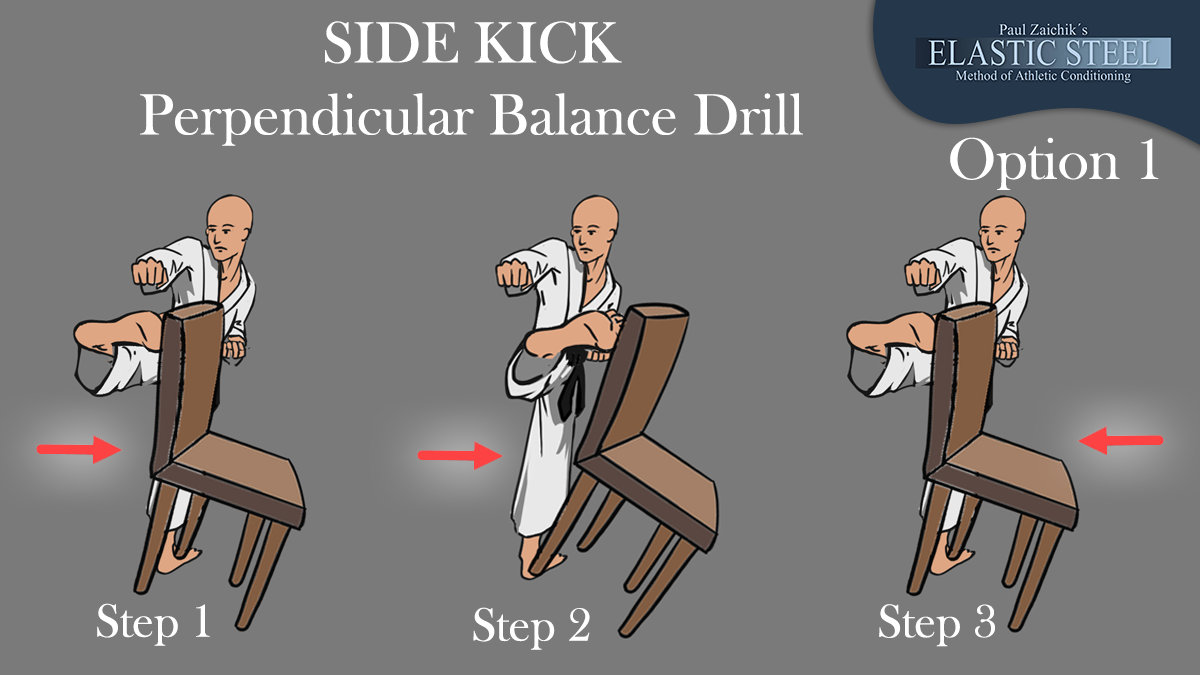
Option 1 (Toes)
- To begin, take a good sturdy chair.
- Place the chair in front of you
- Throw a side kick where you miss the chair
- Touch your toes to the back of the chair
- Now slowly push the chair so that the back legs come off the floor.
- Bring the chair back with control and stop just before the back legs of the chair make contact with the floor.
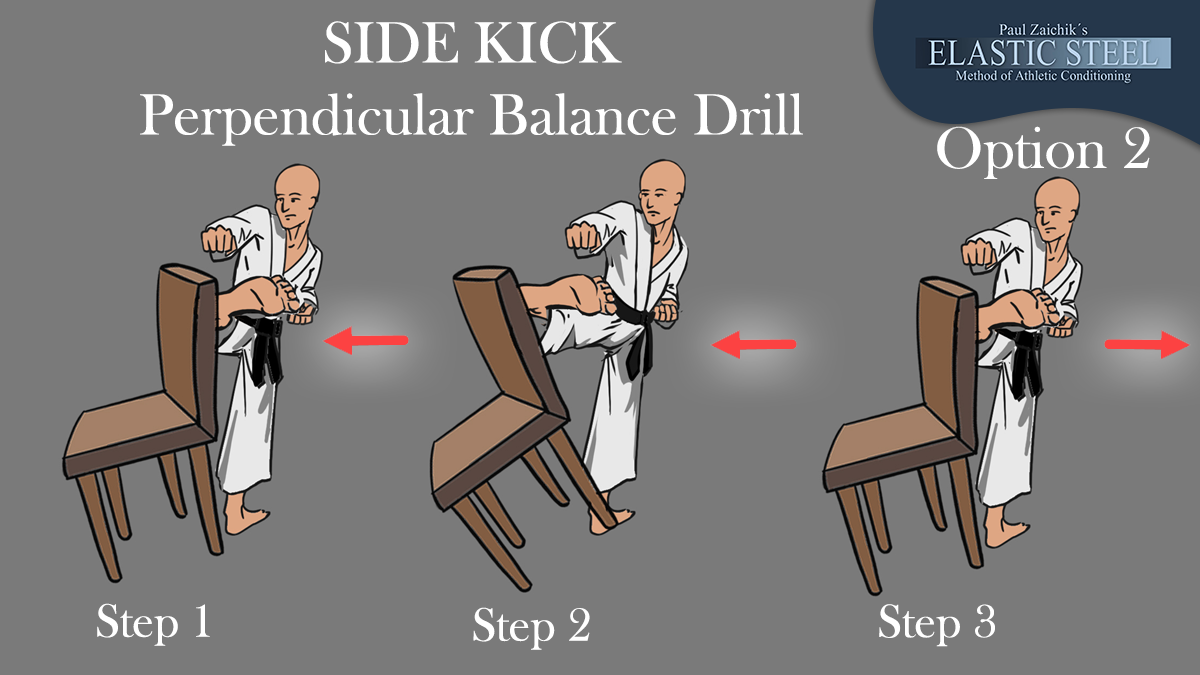
Option 2 (Heel)
- To begin, take a good sturdy chair.
- Place the chair in front of you
- Throw a side kick where you miss the chair
- Touch your heel to the back of the chair
- Now slowly push the chair so that the back legs come off the floor.
- Bring the chair back with control and stop just before the back legs of the chair make contact with the floor.
To get maximum value out of this drill it is important to do it correctly!
When I first did this drill over 30 years ago and I showed it to other martial artists, some of them thought it was a funny drill because it doesn't look like you're really practicing the sidekick. And it doesn't look like it can help to improve the sidekick. And yet when they tried it, they were not able to do it.
However, the few that kept doing the drill were pleasantly surprised at the improvement they got in their sidekick once they got better at the drill. Important tip: when you do this drill, you don't want to kick the chair. The point here is not to work on your hook kick or your roundhouse kick. That's not the point here. The point here is to move slowly with control.
You can move a small distance at first and then increase if you have to, you can place the back legs of the chair on the floor. You can do that. But ideally with practice that should not happen.
What you will notice when you are practicing this drill is that at first you might hop around on your supporting leg. You might drop your torso forward or move your hips back. You might move your arms around. You might bend one leg or the other leg, which is fine in the beginning, but eventually the goal of this drill, is to keep the proper form.
Also, I would like to mention that if you are practicing your techniques for technique competition such as Kata in karate or Hyeong in Taekwondo. If you are practicing for this, your techniques will look a lot stronger, and a lot more crisp after this drill.
If you're interested in specialized kick training programs, not just drills, take a look at the following programs:
However, the few that kept doing the drill were pleasantly surprised at the improvement they got in their sidekick once they got better at the drill. Important tip: when you do this drill, you don't want to kick the chair. The point here is not to work on your hook kick or your roundhouse kick. That's not the point here. The point here is to move slowly with control.
You can move a small distance at first and then increase if you have to, you can place the back legs of the chair on the floor. You can do that. But ideally with practice that should not happen.
What you will notice when you are practicing this drill is that at first you might hop around on your supporting leg. You might drop your torso forward or move your hips back. You might move your arms around. You might bend one leg or the other leg, which is fine in the beginning, but eventually the goal of this drill, is to keep the proper form.
Also, I would like to mention that if you are practicing your techniques for technique competition such as Kata in karate or Hyeong in Taekwondo. If you are practicing for this, your techniques will look a lot stronger, and a lot more crisp after this drill.
If you're interested in specialized kick training programs, not just drills, take a look at the following programs:
ELASTICSTEEL MASTER KICKER COLLECTION
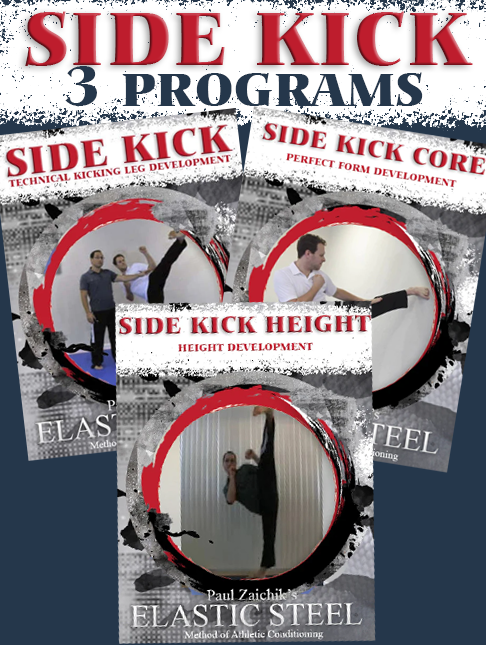
3 Program
Side Kick Combo
Side Kick Combo
This combo includes:
- Technical Kicking Leg Development
- Core Flexibility & Strength Development
- Height Development
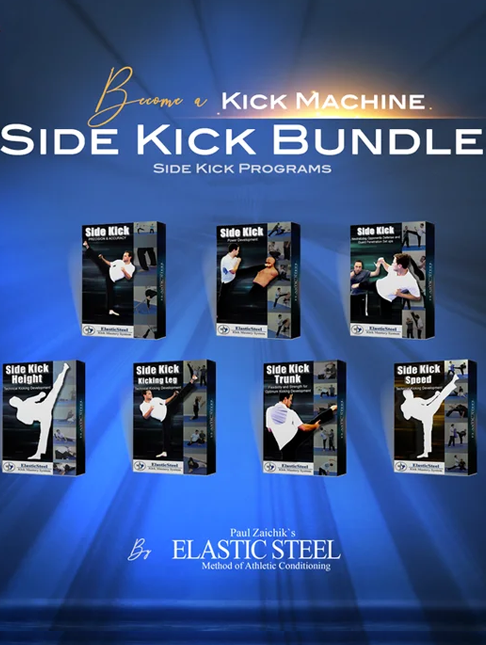
7 Program
Side Kick Combo
Side Kick Combo
This combo includes:
- Technical Kicking Leg Development
- Core Flexibility & Strength Development
- Height Development
- Speed Development
- Precision & Accuracy Development
- Power Development
- Flying Side Kick
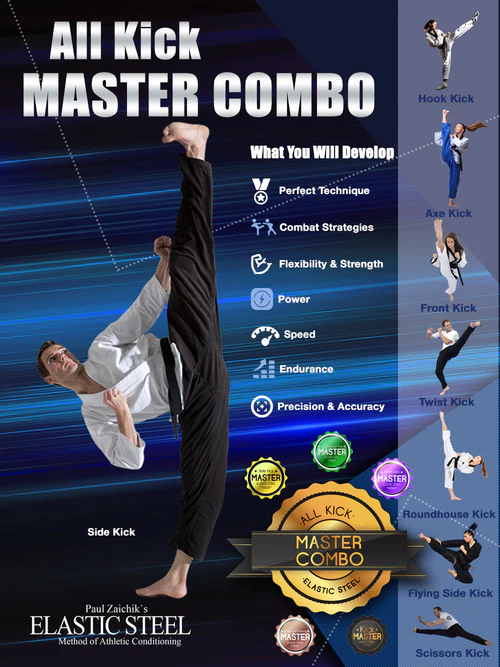
20 Program
All Kick Master Combo
+ 5 Gifts!
All Kick Master Combo
+ 5 Gifts!
This combo includes:
Side Kick:
- Technical Kicking Leg Development
- Core Flexibility & Strength Development
- Height Development
- Speed Development
- Precision & Accuracy Development
- Power Development
- Neutralizing Opponents Defense and Guard Penetration Set Ups
Roundhouse and Hook Kicks:
- Roundhouse Kick: Technical Kicking Leg Development
- Roundhouse Kick: Speed Development
- Roundhouse Kick: Power Development
- Hook Kick: Power Development
Front Kick:
- Front Kick and Front Line Kicks: Technical Kicking Leg Development
- Front Kick: Speed Development
- Push Front Kick: Power Development
- Axe Kick: Power Development
- Ball of the Foot: Point of Impact
Advanced Kicks:
- Scorpion Kick: Perfect form Development
- Flying Side Kick: Technique and Jumping Height Development
- Flying Split Scissors Kick, Two Direction Kick
- Twist Kick Technical Kicking Leg Development
- Twist Kick Follow Along Routine
+ 5 GIFTS!

Leave a comment